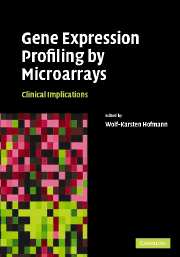Book contents
- Frontmatter
- Contents
- List of contributors
- Foreword
- Introduction
- 1 Technique of microarrays: microarray platforms
- 2 Quantitative quality control of microarray experiments: toward accurate gene expression measurements
- 3 Statistical analysis of gene expression data
- 4 Genomic stratification in patients with heart failure
- 5 Gene expression profiling for the diagnosis of acute leukemias
- 6 Gene expression profiling can distinguish tumor subclasses of breast carcinomas
- 7 Gene expression profiling in lymphoid malignancies
- 8 mRNA profiling of pancreatic beta-cells: investigating mechanisms of diabetes
- 9 Prediction of response and resistance to treatment by gene expression profiling
- Index
- References
7 - Gene expression profiling in lymphoid malignancies
Published online by Cambridge University Press: 05 September 2009
- Frontmatter
- Contents
- List of contributors
- Foreword
- Introduction
- 1 Technique of microarrays: microarray platforms
- 2 Quantitative quality control of microarray experiments: toward accurate gene expression measurements
- 3 Statistical analysis of gene expression data
- 4 Genomic stratification in patients with heart failure
- 5 Gene expression profiling for the diagnosis of acute leukemias
- 6 Gene expression profiling can distinguish tumor subclasses of breast carcinomas
- 7 Gene expression profiling in lymphoid malignancies
- 8 mRNA profiling of pancreatic beta-cells: investigating mechanisms of diabetes
- 9 Prediction of response and resistance to treatment by gene expression profiling
- Index
- References
Summary
Introduction
The development of high throughput technologies and, in particular, of DNA microarrays led to a great leap forward in the understanding of complex biological processes, as highlighted in the previous chapters. Not surprisingly, this technology has also revealed exciting new insights in the field of lymphoid malignancies. Specifically, first steps have been taken towards a molecular classification of lymphomas, and gene expression-based survival predictors for lymphoma patients have been created that may prove useful in guiding future treatment decisions. Importantly, oncogenic pathways and relevant biological features of various lymphoma subtypes have been uncovered that may facilitate new targeted treatment approaches.
Traditionally, lymphoma classifications have been a topic of hot debate, and various conceptual frameworks have been used in the past to classify lymphomas in a clinically and biologically meaningful way [1]. Early attempts of lymphoma classification relied heavily on either morphological or clinical aspects (e.g., in the Rappaport classification or in the Working Formulation, respectively). In the Kiel classification, cytological and immunologic criteria were applied for the first time to classify lymphomas according to their derivation from the B- or T-cell lineage. The latest approaches to lymphoma classification, the Revised European-American Lymphoma (REAL) and World Health Organization (WHO) classifications, include morphological aspects, immunophenotype and clinical features, but also underlying genetic alterations to define lymphoma subtypes [2, 3]. For example, mantle cell lymphoma (MCL) is now regarded as a distinct subgroup of B-cell non-Hodgkin's lymphoma (B-NHL), characterized by the reciprocal chromosomal translocation t(11;14) that is present in virtually all cases [4].
Information
- Type
- Chapter
- Information
- Gene Expression Profiling by MicroarraysClinical Implications, pp. 162 - 186Publisher: Cambridge University PressPrint publication year: 2006
